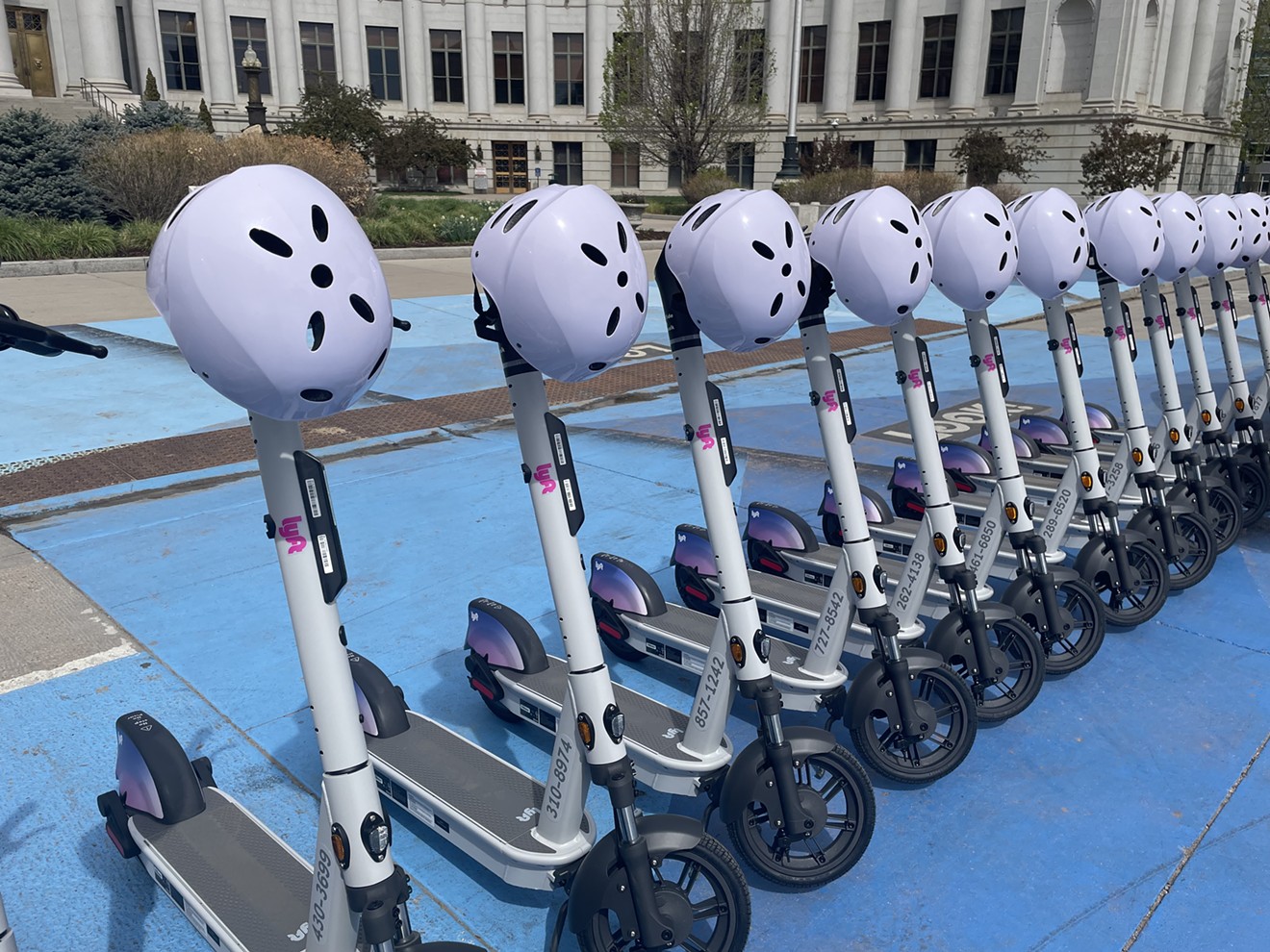“We’re always looking to improve our technology and stay up to date,” says Anna Prisse, general manager of Lyft’s transit, bikes and scooters.
The company rolled out the shiny new whips on May 3. The most obvious difference from the old models is a mostly white paint job that's accentuated by pink and purple ombre wheel covers. The color scheme is more reflective and likelier to be seen at night than the previous black design.
The older scooters are still on the streets, but will gradually be replaced as their life spans wane.
Prisse says Lyft's transit team has been focused in on this launch, with hopes of making its scooters more desirable to ride.
A shining example of this is the scooter's new mounted phone holder, which allows for easier GPS access and even charges the phone while you ride. Now, Prisse notes, people can confidently use Lyft's new in-app navigation system without worrying about holding their phone in one hand and the handlebars with the other, and without draining their battery on a night out.
“Safety for tourists having directions turn-by-turn on the scooter is great,” she says, adding that while some people have Denver’s bike lanes memorized, that isn’t the case for all scooter riders.
A band on the trunk of the new scooters will change colors to indicate slow zones, no-parking zones and no-ride zones — potentially alleviating some of the pedestrian- and car-related conflicts that have given scooters a bad name. Lyft is testing out AI capabilities on the scooters in a pilot program in Washington, D.C., to refine their detection of these zones.
There’s also a big sticker on the new scooters reminding people not to ride on the sidewalk. Other safety improvements include screens to tell riders how fast they’re going, turn signals and hand brakes. “You don't have to take your hands off for anything,” Prisse notes.
The front tire is larger than the previous model's, and both tires on the new model are air-free to prevent flats. A new suspension system is supposed to make rides less bumpy.
Adrienne Razavi, organizing manager for the Denver Streets Partnership, attended a Lyft open house on May 3 to check out the new scooters. Razavi has chronic back pain and has always opted for bikes over scooters because of the latter's bumpy ride.
She says the new scooters look much sturdier and could make them a more viable option. “When you take alternative transportation, you want to have as nice of a ride as you would in a car,” she says. “This is going to feel like a nice ride.”
Like Razavi, Prisse has a preference for bikes. Now that the scooters have been updated, however, she says she loves them, too. Getting more people to use alternative forms of transit is important to both Lyft and the Denver Streets Partnership, the women say.
Personal-injury attorneys in Denver have seen countless cases of cars hitting scooters in recent years. Occasionally, there are also cases where scooters hit pedestrians — or where a technological malfunction causes a scooter crash.
“There are instances, very frequently, when the brakes might not work as they should or some other feature causes the accident or contributes to it,” says Vance Larimer, a partner at the legal firm Larson Larimer Schneider. “I believe their intent for trying to [make these changes] is to limit their liability, exposure from lawsuits, and obviously make it more safe for people as well.”
Larimer says updated scooters could be less likely to malfunction and cause a crash.
Kevin Cheney, a personal-injury attorney at Cheney Galluzzi & Howard LLC, says that updates like Lyft's turn signals and phone holders are a win-win for everybody.
“They want people to feel safe on the scooter so they'll keep riding,” he points out.
It’s typically difficult to pursue action against scooter companies for technical malfunctions, both attorneys note. The terms and conditions riders agree to include language regarding arbitration that makes it difficult to take companies to court, Cheney says.
He lives in RiNo and rode the scooters regularly when they first rolled out, but after his firm got so many scooter cases — and he saw photos of enough injuries — he put an end to his riding days.
Cheney believes the larger front wheel, extra visibility and phone mount will help with safety issues; still, he doesn’t think he'll be riding scooters again anytime soon.
Larimer’s nephew was just in a scooter accident in Phoenix. He wants people to know that they should wear a helmet if they’re riding an electric scooter; some scooter companies specify in their terms of service that people wear helmets while riding.
“I'm of the belief that helmets should be one of those Denver accessories,” says Francisco Partida, Lyft operations manager. “Everybody has a Hydro Flask and a dog and a puffer vest. People should start hanging their helmets from their backpacks.”
Cheney says individual lawsuits can only do so much, especially when companies are often more powerful than people. He thinks changes to the law will be needed for sweeping safety reform.
In the meantime, any changes that make scootering safer are a plus.
“There's enough injuries and crashes out there when people are being safe,” Cheney says. “Anything that we can do to try to make people safer when they're out in our city is in our favor. … Do I think this will help? Yes. Do I think it's going to be a silver bullet and all of a sudden we're going to see a lot less crashes? Probably not.”
Along with the scooter rollout, Lyft is piloting an electric van fleet to cut down on emissions while servicing the scooters. Right now, 20 percent of its fleet in Denver is electric, and the company plans to be fully electric by 2030, which would result in a 46 percent emissions reduction.
Because of less tire maintenance and a longer battery life with the new scooters, Prisse says the environmental benefits will go even further, because the vans will not need to drive around as much to keep the scooter fleet in good repair.
“This will help clear some contention between drivers and scooters,” Razavi adds. “Companies like Lyft and organizations like ours are trying to make it so that the street is truly shared for all the people who want to get around, the way they want to get around. … I'm excited to see how this improves people's use of scooters.”














